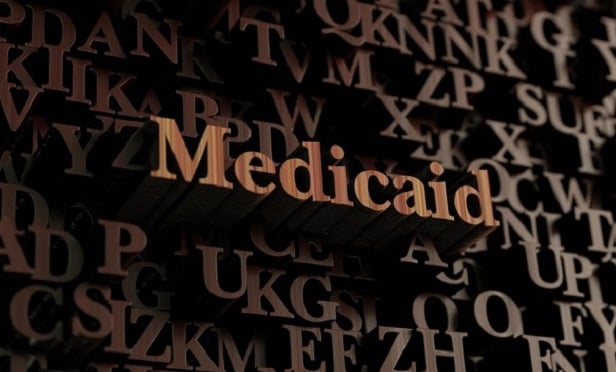 In New Mexico,a projected 16,000 people would enroll in a Medicaid program, andtheir premiums would be 15 to 28 percent lower than plans sold onthe individual market. (Image: Shutterstock)
In New Mexico,a projected 16,000 people would enroll in a Medicaid program, andtheir premiums would be 15 to 28 percent lower than plans sold onthe individual market. (Image: Shutterstock)
Laura Lucero Y Ruiz De Gutierrez has a heart condition andfibromyalgia and is in danger ofdeveloping diabetes. She has health insurance through herhusband's job. But, between the $800 monthly premium for thecouple's coverage and the $2,100 deductible she has to pay downbefore insurance starts picking up the tab, she doesn't feel shecan afford to go to the doctor when she needs to.
|She hopes that may soon change. Identical bills proposed inrecent weeks in the New Mexico House and Senate would make Gutierrez eligible to buy in to a publichealth plan modeled on Medicaid. She also could receivestate-funded assistance that would save her hundreds of dollars amonth on premiums.
|As “Medicare for All” has become a rallying cry for progressiveDemocrats, New Mexico is one of several states looking at offeringconsumers a different government-sponsored plan to provide a moreaffordable health option. The proposals, often referred to as“Medicaid buy-in” plans, would typically offer benefits similar towhat is available in Medicaid, the state-federal health plan forlow-income people.
|“Medicare for All is not going to happen legislatively in thenext couple years. But in the meantime states are saying, 'Whatabout “Medicaid for more”?'” said Heather Howard, who directsPrinceton University's state health and value strategiesprogram and is working closely with some of the states.
|A report commissioned by New Mexico projected that up to 16,000people would enroll in a program like the one originally proposedin the bills, and their premiums would be 15 to 28 percent lowerthan plans sold on the individual market.
|Gov. Michelle Lujan Grisham favors a Medicaid buy-in option. Shedoesn't have a position on the current bill, but she is followingit closely, said Nora Sackett, the governor's deputy presssecretary.
|In addition to the governor's and lawmakers' interest, otherstakeholders have been deeply involved, increasing the odds ofsuccess, Howard said.
|Lawmakers in Colorado, Oregon, Washington and Minnesota areamong others exploring similar options, said Howard. Nevadalawmakers passed a bill last year that would have set up a Medicaidbuy-in plan, but the Republican governor vetoed it.
|“The proposals take on different flavors depending on the state”and what officials are trying to accomplish, she said, whether it'sincreasing the number of people with insurance, making coveragemore affordable or helping states avoid “bare” counties where nomarketplace plans are offered.
|States that want to offer a buy-in option might opt to try toexpand Medicaid directly, or offer a plan that builds on but is notpart of their Medicaid program, with similar benefits, providersand reimbursement rates. Or they may offer a public optioninsurance plan that isn't based on Medicaid. Depending on how theystructure their plan, states may have to get approval from thefederal government to move ahead.
|A federal bill that would allow states to open up their Medicaidprograms to all residents was reintroduced earlier in February bySen. Brian Schatz (D-Hawaii) and Rep. Ben Ray Luján (D-N.M.).
|In New Mexico, the buy-in plan would be similar to the state'sMedicaid program. It would be offered outside the exchange andwould not require federal approval to implement. The state wouldprovide financial assistance to help low-income people buy in toit.
|New Mexico's bill would target individuals who aren't eligiblefor Medicaid or Medicare or those who can't get the Affordable CareAct's premium subsidies because their incomes are above 400 percentof the federalpoverty level (about $50,000 for one person or $103,000 for afamily of four). It also includes immigrants who are in the countrywithout legal status.
|The measure would also help people, like Gutierrez, who arevulnerable to the ACA's so-called family glitch. Her husband's $100monthly premium for single coverage is considered affordable underthe law because it costs less than 9.86 percent of their familyincome of about $46,000 a year. That makes her ineligible forpremium subsidies on the exchange, even though the $800 premium forthe two of them far exceeds that affordability percentage. Theirthree children already have Medicaid coverage.
|“Right now, I pay to have the health care, but I can't afford touse it,” said Gutierrez, 42.
|The bill would provide premium and cost-sharing assistance forpeople with incomes less than 200 percent of the federal povertylevel, or $60,340 for a family of five. The new coverage would takeeffect by January 2021.
|Laura Lucero Y Ruiz De Gutierrez says she is interested in NewMexico's possible Medicaid buy-in plan because she “cannot affordto use” the coverage she has now.
|Gutierrez, whose family lives in Albuquerque, would be eligiblefor financial assistance to help her buy in to the Medicaid option,while her husband stayed on his employer plan. Because their$46,000 annual income is just above 150 percent of the federalpoverty level, her monthly premium would likely be about $160 permonth for a comprehensive plan with a $150 deductible, according toestimates by Manatt Health, which did the original state analysesof buy-in options that were published before the bills wereintroduced in January.
|New Mexico has high levels of poverty, and 40 percent of all New Mexico residents are already enrolled inthe state Medicaid program, compared with about 23 percentnationwide.
|“It's the cornerstone” of our health care system, said ColinBaillio, director of policy and communication at Health Action NewMexico, an advocacy group. The legislation would use “those leversthat Medicaid has to provide comprehensive coverage and acomprehensive provider network.”
|The bills were passed by two legislative committees inmid-February, with instructions for further study to examineexpanding the buy-in plan to more groups. They now move to twoother legislative committees for consideration, Baillio said.
|Hospitals and other health care providers would be reimbursed atMedicaid rates, which are lower than those for commercial plans.Still, to the extent that people who are uninsured enroll in thenew plan, providers stand to gain financially.
|“We're obviously very supportive of anything that expandscoverage,” said Jeff Dye, president of the New Mexico HospitalAssociation. “It's the issue of getting some payment versus nopayment for services rendered.”
|If the Medicaid buy-in bill passes, Blanca Ivon Rodriguez andher husband, Hugo Montes, could have health insurance for the firsttime since they moved to New Mexico 14 years ago. The couple andtheir oldest son, now 18, are immigrants from Mexico who are in thestate without proper legal status. Their two younger children, whowere born in the United States, are enrolled in Medicaid.
|Montes works as a plumber and Rodriguez is studying earlychildhood development at a community college near their home inAlbuquerque. Because they're undocumented, they're notpermitted to buy health insurance on the exchanges, even ifthey're willing to pay full price.
|Like many people without insurance, they wait until they'rereally sick before seeking help. When Rodriguez developed pneumoniaa few years ago, the waiting lists for an appointment at communityclinics that would see her without insurance were long. Finally,when she could no longer breathe comfortably, she went to theemergency department.
|“It would bring us peace of mind not having to worry about ourhealth care situation,” said Rodriguez, 41, through atranslator.
|Providing health care for residents who are undocumented is “anunderlying issue with many states that are considering a Medicaidbuy-in,” said Chiquita Brooks-LaSure, managing director at ManattHealth, who co-authored the reports evaluating Medicaid buy-inoptions for New Mexico.
|Leah Steimel (center) says she would consider buying insurancethrough a Medicaid buy-in plan being weighed by the New Mexicolegislature. Her family includes (from left) her husband,Wellington Guzman; their daughter, Amelia; and sons Daniel andJonathan.
|The New Mexico bill also would provide some relief for LeahSteimel's family. Neither she nor her husband hasemployer-sponsored coverage, and with family income of about$100,000 they don't qualify for ACA premium tax credits. They paymore than $1,900 a month for a silver-level plan with a $10,000deductible to cover themselves and two of their kids (the third isover age 26).
|Buying in to Medicaid would be tempting, said Steimel, 59, whoworks as a community health consultant with some of the groupsadvocating for the buy-in. Sure, she said, she wonders if theMedicaid plan would be as easy to use as a regular commercial planand have access to as many providers.
|“But being able to pay into something that would reduce by evena third what I'm paying now, I'd love that,” she said.
|Kaiser Health News isa nonprofit news service covering health issues. It is aneditorially independent program of the Kaiser Family Foundation,which is not affiliated with Kaiser Permanente.
|Read more:
Complete your profile to continue reading and get FREE access to BenefitsPRO, part of your ALM digital membership.
Your access to unlimited BenefitsPRO content isn’t changing.
Once you are an ALM digital member, you’ll receive:
- Critical BenefitsPRO information including cutting edge post-reform success strategies, access to educational webcasts and videos, resources from industry leaders, and informative Newsletters.
- Exclusive discounts on ALM, BenefitsPRO magazine and BenefitsPRO.com events
- Access to other award-winning ALM websites including ThinkAdvisor.com and Law.com
Already have an account? Sign In
© 2024 ALM Global, LLC, All Rights Reserved. Request academic re-use from www.copyright.com. All other uses, submit a request to [email protected]. For more information visit Asset & Logo Licensing.








